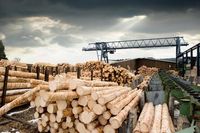Lumber prices, often considered a bellwether for the broader U.S. economy, have tumbled dramatically in recent weeks, sparking fresh concerns among investors, builders, and policymakers about the health of the housing market and the nation’s economic momentum. Since early August 2025, lumber futures have plummeted between 23% and 24%, settling at $526.50 per thousand board feet as of Monday, September 8, according to The Wall Street Journal. The downturn is more than just a blip for commodity traders—it’s a potential warning sign for Main Street.
Wood prices are frequently cited as a leading indicator of housing demand and economic vitality. When lumber gets cheap, it’s often because builders are pulling back, signaling trouble ahead for construction jobs, home sales, and the countless industries that rely on a robust housing sector. As The Wall Street Journal put it, “crashing wood prices are troubling because they have been a reliable leading indicator on the direction of the housing market as well as broader economic activity.”
So, what’s behind this sudden drop? Several factors have converged to send prices spiraling. First and foremost, demand for new homes and construction materials has softened. In July, residential building permits—a key metric for future construction—slipped to just 1.4 million units on a seasonally adjusted annual rate, the lowest level since June 2020. That’s a far cry from the pandemic boom, when Americans rushed to renovate and build homes, driving lumber prices to dizzying heights. Construction spending, too, has taken a hit, dropping by 3.4% in July compared to the record set in May 2024.
Layered atop these demand woes is a swirl of uncertainty over trade policy. The Trump administration’s tariffs and import taxes on Canadian lumber, first imposed years ago, have continued to roil the market. According to The Wall Street Journal, “Trump tariffs and import taxes have caused unpredictable impacts on supply chains.” In recent months, the White House has signaled it is “investigating national security aspects of imported lumber,” and President Trump has threatened “steep tariffs on all Canadian goods.” These threats have led to erratic buying patterns, with prices surging in May 2025 as buyers scrambled to stock up ahead of scheduled hikes in Canadian lumber duties and potential new tariffs. The price plummeted when tariff talk cooled off, only to swing upward again when buyers anticipated further restrictions.
The uncertainty has left sawmills and traders on edge. Two of North America’s largest sawmills responded to the market turmoil last week by announcing plans to scale back production—a move echoed by other mills facing a glut of unsold wood and rising costs. As The Wall Street Journal reported, “two of North America’s biggest sawyers said last week that they would curtail output, slowing the decline.” This decision helped cushion the price drop, but analysts say it may not be enough.
“We anticipate further closures or curtailments,” said Michael Roxland, an analyst at Truist Securities, in remarks reported by The Wall Street Journal. The reason? Higher duties have pushed up Canadian sawmills’ break-even prices at the same time that demand is waning. If the market glut persists, more mills could be forced to idle operations or shut down altogether, putting jobs and local economies at risk.
Tariffs aren’t the only policy headwind. The Federal Reserve’s campaign to rein in inflation by raising interest rates, which began in 2022, has also weighed heavily on the housing market. As borrowing costs climbed, homebuyers and developers grew more cautious, leading to a slowdown in new construction. Lumber, which soared during the pandemic when supply chains were snarled and demand was off the charts, was “among the first assets to decline in value” as interest rates rose, according to The Wall Street Journal.
It’s worth recalling just how wild the ride has been. During the Covid-19 lockdowns, two-by-four prices nearly tripled their pre-pandemic record, an early sign of the inflation and broken supply chains that would bedevil the economic reopening. The ensuing months saw prices swing with every twist in trade policy and every shift in consumer sentiment. Now, with prices falling fast, the market is once again signaling caution.
For many in the industry, the current slump feels eerily familiar. “Crashing lumber prices are sending a troubling warning sign for the U.S. economy,” The Wall Street Journal warned on Monday. The ripple effects are already being felt. Mills are cutting back, builders are pausing projects, and communities that depend on forestry jobs are bracing for leaner times. The Trump administration, for its part, is reportedly considering even more tariffs on imported wood, citing national security concerns—a move that could further disrupt supply chains and pricing.
The broader economic implications are hard to ignore. When the housing market stumbles, it often drags other sectors down with it. Fewer homes being built means less demand for appliances, furniture, and everything from drywall to doorknobs. Construction jobs, which are a vital source of employment in many regions, could be at risk if the slowdown persists. And with consumer confidence already jittery after years of inflation and interest rate hikes, another downturn in housing could sap momentum from the broader recovery.
Yet, it’s not all doom and gloom. Some industry veterans note that lumber prices remain above their long-term historical averages, even after the recent plunge. And while the current downturn is sharp, it follows a period of extraordinary volatility and record highs. If mills can adjust output and policymakers can bring clarity to trade rules, the market may yet find its footing.
Still, the message from the wood market is clear: caution is warranted. As The Wall Street Journal observed, “lumber prices are signaling caution again.” For now, all eyes are on the sawmills, the White House, and the Federal Reserve. Will further production cuts stabilize prices? Will new tariffs disrupt supply chains even more? And, perhaps most importantly, will the housing market bounce back—or is this the start of a more prolonged slowdown?
For Main Street and Wall Street alike, the stakes couldn’t be higher. The next few months will reveal whether this is just another bump in the road—or a sign of deeper economic trouble ahead.




